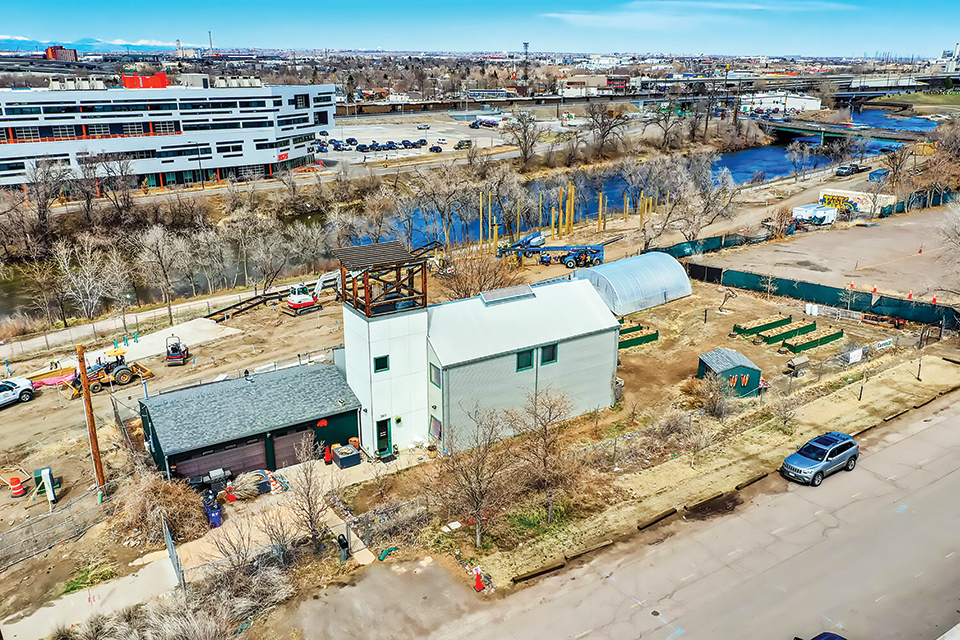
Last month, when the news broke that Tracy Weil was selling his RiNo property, a few shivers went down the spines of those who remember the earliest days of River North. Weil, an artist, community activist, and Denver native with deep roots, helped to conceive the idea of what would become RiNo in the early 2000s.
The area where Weil built his house was all but a blight back in the day. His friend and mentor Mickey Zeppelin of Zeppelin Development, who had already been living in the area, drove Tracy around to find him a spot of his own. There was very little residential activity in the industrial area just off of the Washington exit from I-70. But it was cheap and gritty and right next to the Platte. With the help of architect David Lynn Wise, Weil went through arduous battles with the city concerning stringent commercial zoning laws. After realizing his dream of a live-work space which included a gallery area and, eventually on the property, room for urban agriculture in the form of heirloom tomatoes, other creatives were soon to follow this innovative example.
Little did Weil and Wise realize it, but they jump-started a trend where artist desires were realized in this live-work model. Wise reflected on this “truly transformative period” that influenced how the artist community goes about inhabiting spaces in Denver. Their pioneering persistence with the zoning department paved the way for more local creatives to imagine their own unique studio/gallery dwellings in the industrial area. “The whole district became a metaphor for exploration,” says Wise.
Zeppelin reminisced about Weil’s “fairy tale” progression in the community. “I watched him grow up from being a dishwasher to manager at our bar, City Spirit in Lower Downtown. He was just starting out with his art then and once he got involved in RiNo he really blossomed as a community organizer. It is a weird and wonderful thing for him to be leaving the house that he put so much of himself into. We never would have anticipated what would happen to the area so quickly.”
When asked if the original spirit of RiNo was surviving all the development, Zeppelin came back with a quick “No.” He offered that in the early days there was an intensity of community and appreciation for local artists that seems to have dissipated with the overdevelopment. “You can’t sustain that grassroots feeling in an area when developments prioritize the dollar over blending into a community.”
Wise expressed similar thoughts, citing legendary urban studies activist Jane Jacob’s assertion that rapid escalation of development attempting to commodify an area’s vitality, in its haste, often ends up causing stagnation of that very vitality that attracted people to the area to begin with. “You just can’t purchase the spirit of a place, especially if you knock down most of the original structures that encompassed much of the character.”
Weil’s house sits across Chestnut Place from Ironton (now Ironton Distillery) which was one of the first collective of artist studios in River North. Artist Yoshitomo Saito acquired his studio there 16 years ago after moving from California. He found the area to be much more affordable and benefitted from the rich culture of artists inhabiting Ironton. When asked how the swift development in the area has affected him, Saito responded, “It has come down on me like a humongous tsunami wave, drowning me through the inhalation of water called business development. Yet somehow I have survived.” He added that he is pessimistic as to whether supporting local artists will remain a priority in the area. “RiNo was a creative zone before it became a valuable area for real estate development. The artists made the area thrive because of its affordability. Big development is a sign of a good economy I suppose, but this has had no positive effect on my art sales.” Saito added that he values the work that Weil put into keeping the area a place for authentic artistic development, citing his “genuine character, always caring for others in the community, I wish him luck.”
Weil has secured himself a new studio space near the RiNo District and is currently looking for a new home where he can also continue his agricultural ambitions. He briefly commented that, “While I am moving houses, this area will always be my home. I’ve worked really hard to make sure that art is a vital part of this community long-term and I look forward to continuing that work as a steward for the art district for years to come.” As the development continues to encroach on the area with tall buildings enveloping the spot where Weil lived for 22 years, many view Weil’s exodus as a metaphor for the end of an era.

Be the first to comment